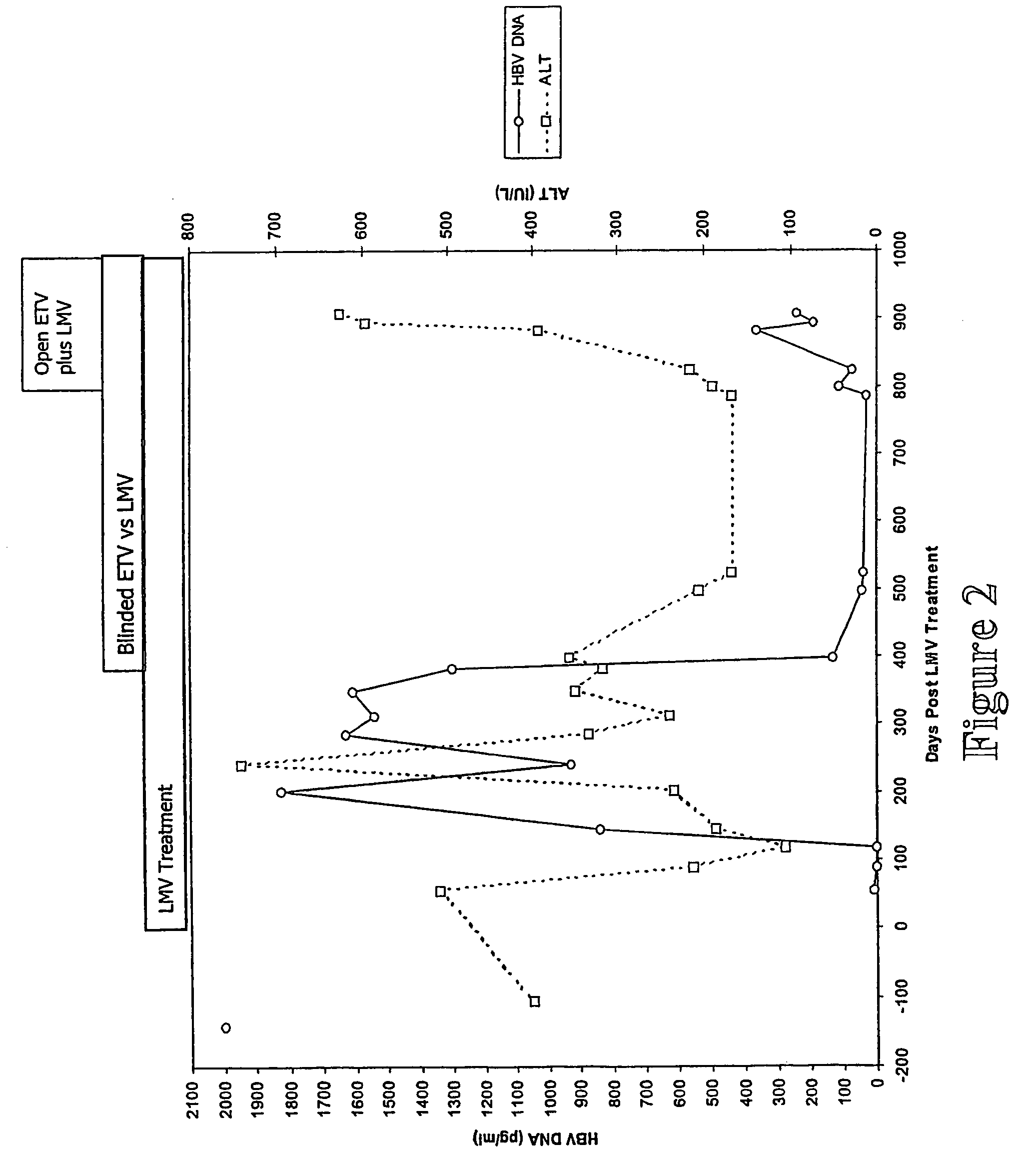Viral variants with altered susceptibility to nucleoside analogs and uses thereof
a nucleoside analog and variant technology, applied in the field of viral variants, can solve the problems of acute liver failure, lmv monotherapy seems unlikely to be able to control hbv replication in the longer term, etc., and achieve the effects of reducing interactivity, reducing sensitivity to particular agents, and reducing interactivity with immunological reagents
- Summary
- Abstract
- Description
- Claims
- Application Information
AI Technical Summary
Benefits of technology
Problems solved by technology
Method used
Image
Examples
example 1
Overlapping Genome of HBV
[0310]The overlapping genome of HBV is represented in FIG. 1. The gene encoding DNA polymerase (P), overlaps the viral envelope genes, Pre-S1 and Pre-S2, and partially overlaps the X and core (C) genes. The HBV envelope comprises small, middle and large HBV surface antigens. The large protein component is referred to as the HBV surface antigen (HBsAg) and is enclosed by the S gene sequence. The Pre-S1 and Pre-S2 gene sequences encode the other envelope components.
example 2
Patient and Treatment
[0311]Patient A is a 44 year old male with chronic hepatitis B presented on Day 0 (9 Jul. 1999) with raised serum HBV DNA levels (>2000 pg / ml) and was commenced on LMV treatment immediately (FIG. 2). The patient A was HBsAg positive and anti-HBe positive. Following the initiation of LMV treatment the HBV DNA levels fell to 8 pg / ml over 54 days of therapy. The HBV DNA levels remained low until day 199 when there was a relapse in replication such that HBV DNA levels reached 1826 pg / ml. By Day 241 the serum ALT peaked at 741 Iu / l. The HBV DNA was sequenced and LMV resistant virus was detected. The patient was then enrolled on Day 382 (24 Jul. 2000) into a blinded ETV plus LMV clinical trial. HBV DNA levels only decreased to 33 pg / ml and the ALT decreased to 167 IU / L by day 784. The patient was started on open label ETV plus LMV. However, both HBV DNA levels and ALT continued to rise and the HBV DNA was sequenced at day 894 (FIG. 2).
[0312]Patient B is a liver transp...
example 3
Detection of Viral Markers
[0313]Hepatitis B surface antigen (HBsAg), hepatitis B e antigen (HBeAg), anti-HBe and hepatitis B core antigen (HBcAg) specific IgG and IgM were measured using commercially available immunoassays (Abbott Laboratories, North Chicago, Ill., USA). Hepatitis B viral DNA levels were measured using a capture hybridization assay according to the manufacturer's directions (Digene Hybrid Capture II, Digene Diagnostics Inc., Beltsville, Md.). The manufacturers stated cut-off for detecting HBV viremia in clinical specimens was 0.7×106 copies / ml or 2.5 pg / ml, [Hendricks DA, et al., Am J Clin Pathol 104: 537-46, 1995].
PUM
| Property | Measurement | Unit |
|---|---|---|
| volumes | aaaaa | aaaaa |
| volumes | aaaaa | aaaaa |
| volumes | aaaaa | aaaaa |
Abstract
Description
Claims
Application Information
 Login to View More
Login to View More - R&D
- Intellectual Property
- Life Sciences
- Materials
- Tech Scout
- Unparalleled Data Quality
- Higher Quality Content
- 60% Fewer Hallucinations
Browse by: Latest US Patents, China's latest patents, Technical Efficacy Thesaurus, Application Domain, Technology Topic, Popular Technical Reports.
© 2025 PatSnap. All rights reserved.Legal|Privacy policy|Modern Slavery Act Transparency Statement|Sitemap|About US| Contact US: help@patsnap.com



